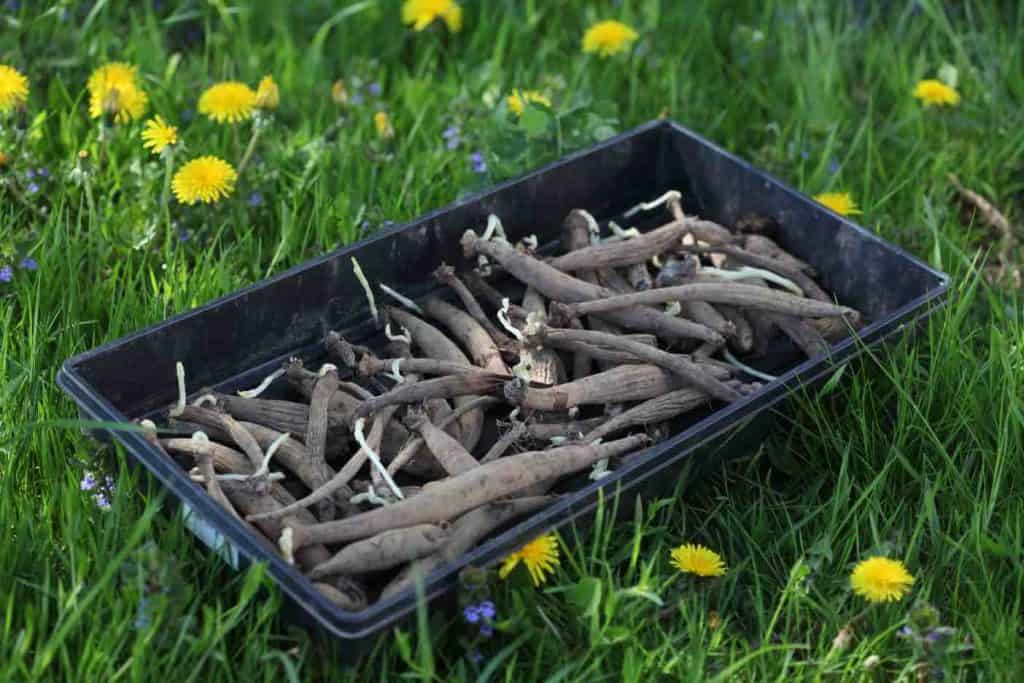Table of Contents
Don’t you think planting Dahlia Tubers is too difficult? Well, there are three ways to grow Dahlias potted plants, seeds, and tubers. While the planting process is relatively simple, the trick to successful flowering lies in the timing.
The only thing that matters is one must be aware of when to plant dahlia tubers or seeds or cuttings from a healthy plant to grow another healthy plant. Before we get into that, let us learn a little about these beautiful flowers called Dahlias. Dahlia is a genus of tuberous and bushy perennial plants native to Mexico and Central America. These are common house and commercial plants. There are more than 40 real species of Dahlia that can be found, and each has specific characteristics. Besides that, there are also several hybrid varieties.
With one head per stem, some can get flowerheads as small as 5 cm in diameter, while the enormous variety can grow up to 30 cm.
When to Plant Dahlia Tubers?
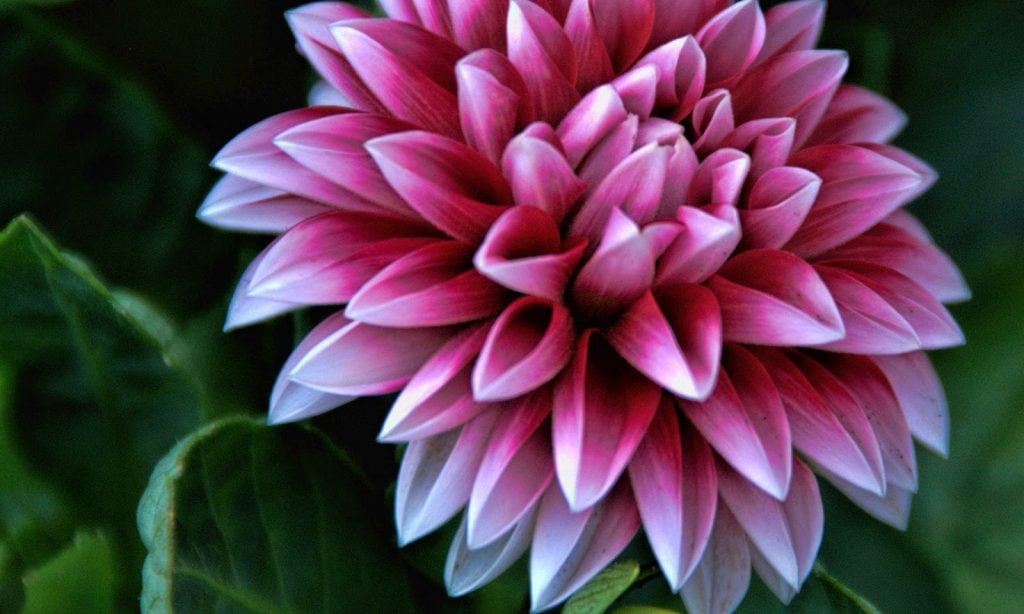
The best time to plant Dahlia tubers for favourable results is when the weather is warm, and there are little to no chances of the soil freezing over. In simple words, after the winter has passed. For indoor planting purposes, the tubers can be planted in February or March. In some places, the warm weather can be a bit later or earlier, so the time to plant Dahlia tubers depends on the climate of an area.
If you wish to see the flowers bloom as early as possible, then you can plant the dahlia tubers indoors a month before when you plant them in the outside soil. By doing this, you can relocate the germinated tuber when spring starts and get flowers shortly after. The most common mistake many people make with planting Dahlia tuners is planting them outside when the ground is still cold. The tubers will not germinate if left out in the cold, and you must wait until the ground temperature rises to at least 15°C before you can plant the tubers into the garden soil. This is why you plant the tubers indoors first and place them in a warm spot, and then transfer it outside when the weather gets warm enough.
5 Steps to Plant Dahlia Tubers
After getting an idea of when to plant Dahlia tubers, growing them perfectly is the next method to move ahead. Here are five crucial steps that every gardener, whether an amateur or pro, should be following to get the gorgeous flowers that Dahlia plants are known so much for.
1. Select the Dahlia Tuber
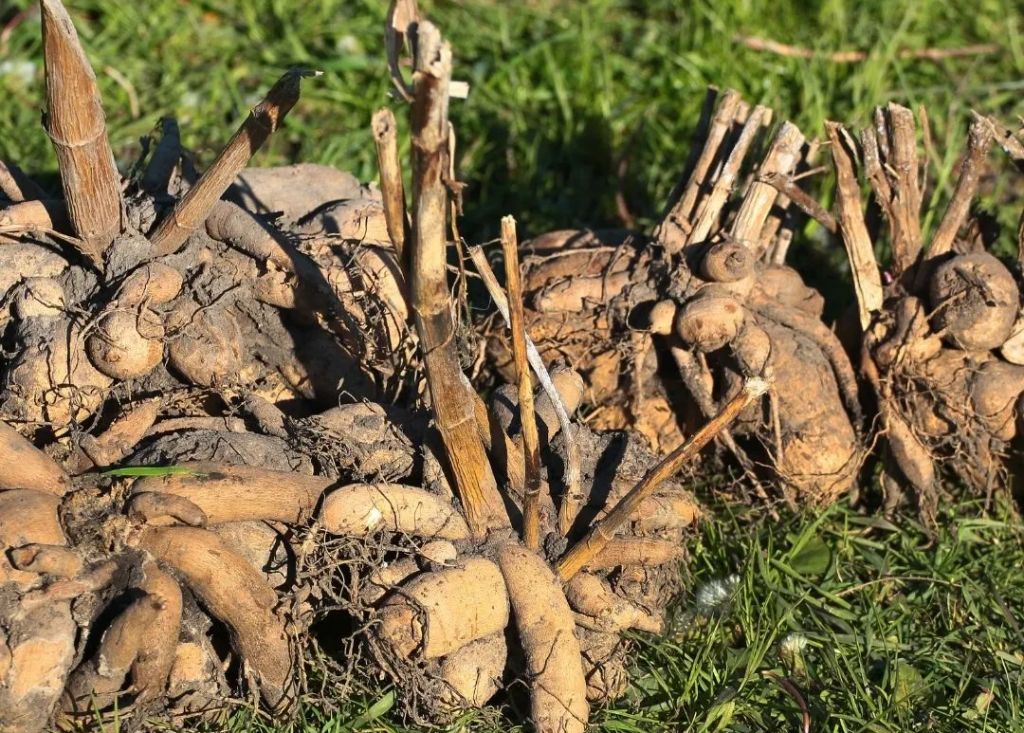
It is an obvious fact that a tuber from a healthy plant will give birth to another healthy plant. So, your priority should be to source a good Dahlia tuber. But how should you know which one to choose? Here is how.
You are likely to find multiple plump tubers in one spot. Start by gently pressing each one, and if you find a squishy and soft one, then cut it out. That is a rotten, destroyed tuber. Check for any discoloration and weak spots, and trim them off. Some tubers may have just started to rot but cutting off that part will stop the damage. However, if you plant a rotten one, then zero amount of watering, sunlight, or fertilisers will get it to grow. There are many sizes in which dahlia tubers are found, and it is not necessarily true that only big plump ones can grow into healthy plants. Small and thin tubers can also be suitable to be planted. Basically, what you have to check is the neck and eye of the tuber are intact and that the body contains enough moisture. If the outer layer seems wrinkly, then it has either died out or starting to do so. You can check by cutting off the end. If the center is still white, then it can still be planted. But if the centre has turned brown, then the tuber is too dry to yield a stable Dahlia plant.
You also have to check the tubers for any mottling because, in that case, it is most likely infected with a virus and should be discarded immediately.
2. Select a Suitable Location
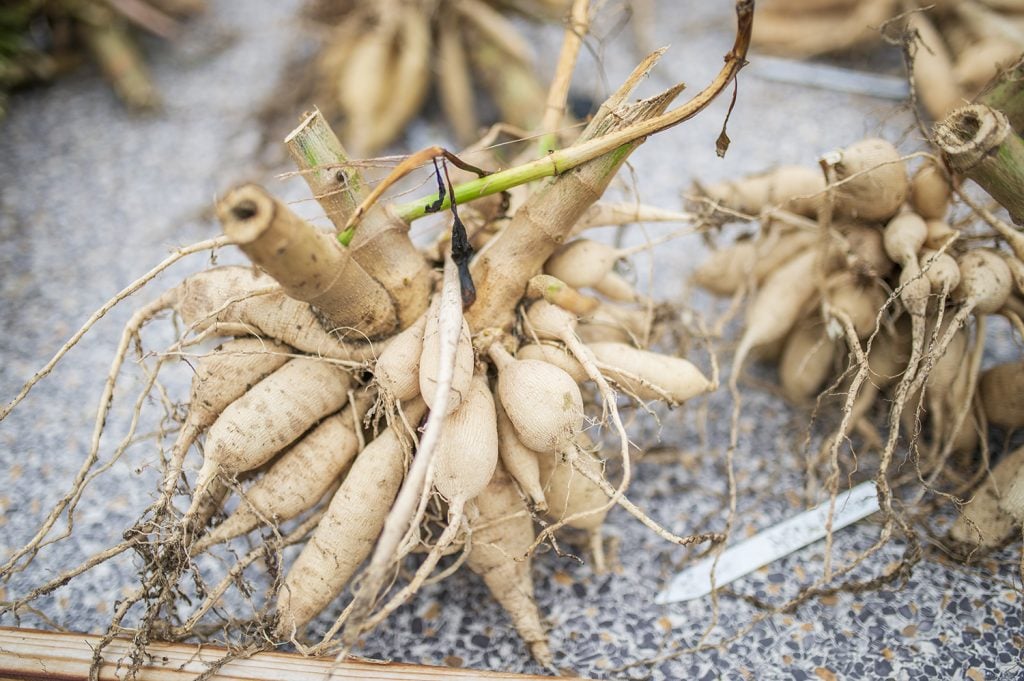
Knowing when to plant Dahlia tubers and which ones to plant is quite important. However, proper care should be taken in the Dahlia productive area. Dahlias grow best in warm and sunny places, but prolonged exposure to high temperatures can affect plant quality. If you are planting it indoors, then the conditions are easy to meet as room temperature can be controlled.
The tubers, however, will need direct sunlight for at least 6-8 hours. Therefore the ideal spot for planting the tubers indoors will be a place where you can expose the pot to the sun when necessary and remove them afterward.
For outdoor planting purposes, you also have to be careful of the soil type. This might sound a little funny, but Dahlias love to grow in the dirt, which implies that the tubers will bloom only when planted in loose and well-draining soil. So you have to choose an area that has a similar soil type. If you have clay or a thick and heavy kind of soil at hand, then you can loosen it with sand and then plant the tubers in it.
Store-bought garden soil is not recommended because dahlia tubers do not grow well. Soil fertility is another important issue, but dahlias that grow in gardens do not need as much feeding as potted ones.
3. Getting the Containers Ready
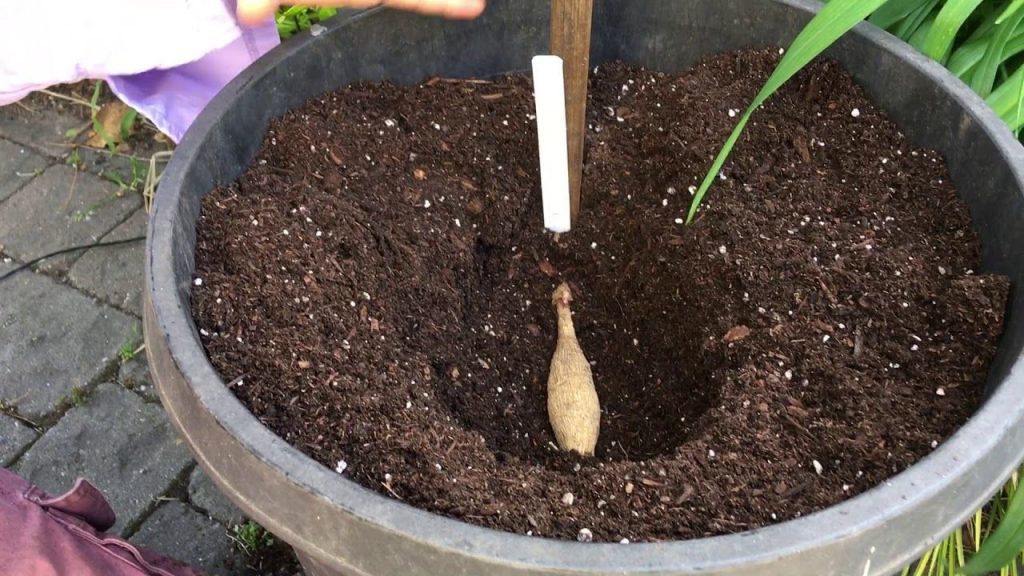
If you are planning to get flowers very soon, then it is best that you get a headstart and plants the tubers indoors in a pot by the end of winter. You can always relocate them to a permanent position when mid-spring arrives. Prepare the temporary container by filling it with potting mix consisting of multipurpose compose. This potting compost can be made at home, and for it, you have to mix two parts compost,1 part manure/worm castings, two parts coconut coir, 1 part perlite, and a handful of slow-release fertiliser pellets. Mix these thoroughly, and to loosen up the potting mix, add some sand to it.
The size and depth of the container do not matter, as you will eventually transfer the tubers once the shoots start appearing. However, the temporary container should still have enough drainage so the soil is not waterlogged, moist, or wet. You need to be sure about one thing, and that is if the ground is not well-drained, the tubers will rot before they form any shoots.
4. Planting the Dahlia Tubers
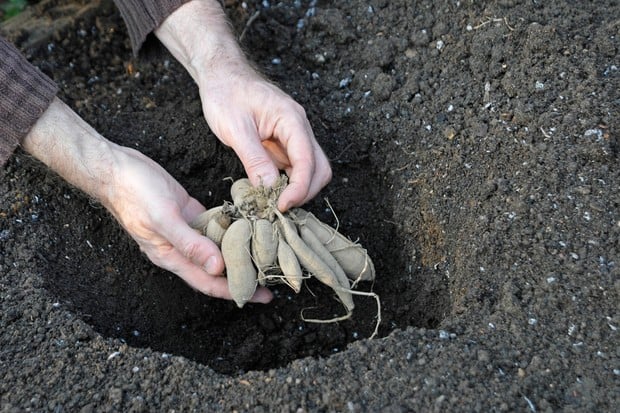
Like many other plants, Dahlias can be planted both indoors and outdoors. The most preferred type for indoor Dahlias includes those varieties that grow to a manageable size. Similarly, the sort found in the garden is usually the bigger ones. However, you may spot smaller varieties planted on the garden soil without a hard and fast rule.
How to Plant It Indoors
Assuming that you have planted the dormant tubers in a pot of multipurpose compost right after the frost passed, your tubers should now be ready to be moved into permanent pots. When planting the dormant tubers into the new pot, ensure that the joint where the sausage-like structure is linked together stays upwards. You do not have to bury it in the compost but rather place it under one layer of light compost soil.
How to Plant It Outdoors
You have to prepare the planting site before bringing the tubers to it. Since we already know dahlias flourish in loose, fertile, and draining soil, dig in lots of organic compost matter such as rotten manure or any other suitable alternative. Adding some all-purpose fertiliser to the mix is also recommended, as this will help the plant to grow fast and sturdy. Planting it in the soil should be done in the same way as it was produced in the temporary pot.
Ensure the joint from which the multiple tubers branch out stays upwards when in the soil. There should be at least a space of 2 feet between two planting sites because the roots in the underground need space to establish themselves well.
5. Mulching for Dahlia Growth
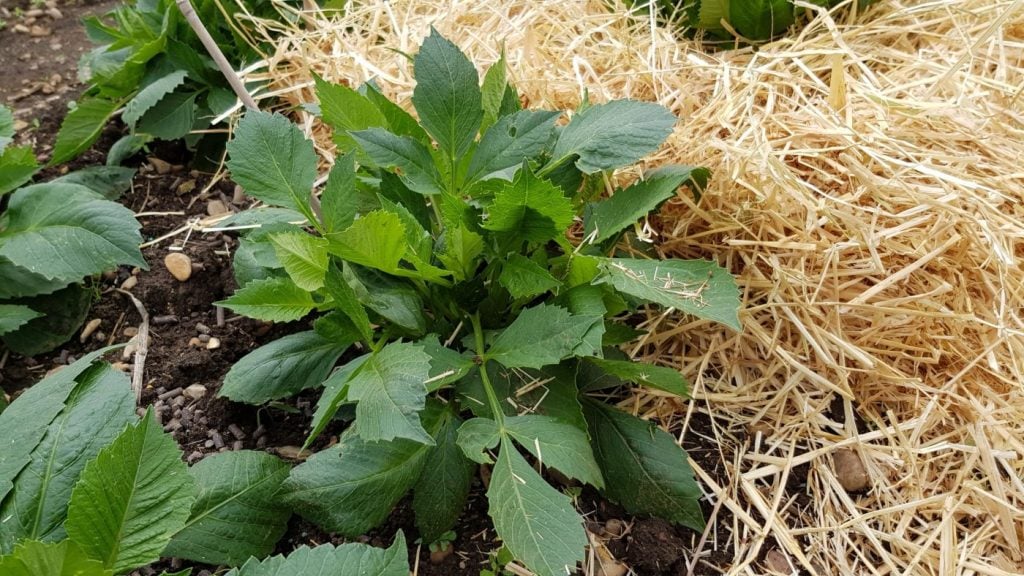
After you have completed the above steps, it is time for the final step in planting dahlia tubers, which is mulching. Many gardeners prefer to apply the mulch material right after planting and feeding to retain nutrients and moisture. The mulching material can be a weed membrane or any organic materials, for example, compost or straw.
Mulching is just as important as knowing when to plant dahlia tubers and how to do it, as it has several advantages. It prevents weed growth and excessive sunlight from reaching the roots and making them rot. It also helps the plants to retain moisture by keeping any liquid feed available for longer durations which in turn lessens the need for watering and feeding the plant.
It also helps the plant to retain the warmth they get from the sun as the mulch holds on to the heat even after the sun has set. This allows the roots to maintain an optimal temperature that does not let the plant get too hot or cold, thus boosting its healthy growth.
Final Thought
In conclusion, there is no doubt about the fact that Dahlias are one of the most beautiful flowers to exist. They can uplift anyone’s mood with their bright and vigorous flora that come in many sizes and colours. But proper care has to be given to the young shoots before they finally emerge into those beautiful flowers.
This is especially true if your garden tends to attract pests and insects. Slugs, for instance, can mostly be spotted on tiny shoots that have just started to grow. And when the shoots grow into little succulents, pests that can fly will be attacking you more than those which can crawl.
You should try to remove these as soon as you spot them so that the plants can grow to their maximum potential.

